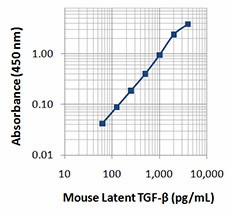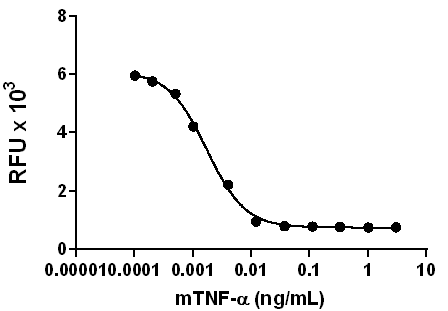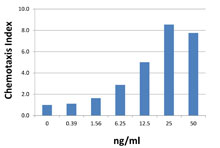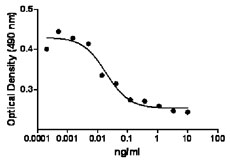- Regulatory Status
- RUO
- Other Names
- Latent TGF-β1, Latent TGFβ, Latent TGFβ1, LTGF-β1, LTGF-β, LTGFβ1, LTGFβ, Latent transforming growth factor beta
- Ave. Rating
- Submit a Review
- Product Citations
- publications

| Cat # | Size | Price | Quantity Check Availability | Save | ||
|---|---|---|---|---|---|---|
| 594509 | 4 pack | 76€ | ||||
Latent TGF-β is secreted as a complex consisting of LAP and TGF-β1. LAP and TGF-β1 are synthesized as a single propeptide precursor of 390 amino acids with an N-terminal signal peptide of 29 amino acids, a 249 amino acids pro-region (LAP), and a 112 amino acids C-terminal region (TGF-β1).
Both LAP and TGF-β1 exist as homodimers in circulation, but the disulfide linked homodimers of LAP and TGF-β1 remain non-covalently associated, forming the small latent TGF-β complex (SLC, 100 kD). The large latent TGF-β complex (LLC, 235-260 kD) contains a third component, the latent TGF-β binding protein (LTBP), which is linked to LAP by a single disulfide bond. LTBP does not confer latency but is for efficient secretion of the complex to extracellular sites.
TGF-β1 and LAP can be released (activated) by many factors, including enzymes and low or high pH. TGF-β1 and LAP have multiple functions, such as regulating proliferation and differentiation of various cell types.
Increased production and activation of latent TGF-β have been linked to immune defects associated with malignancy and autoimmune disorders, to susceptibility to opportunistic infection, and to the fibrotic complications associated with chronic inflammatory conditions.
Latent TGF-β has been found to protect against glomerulonephritis. It is a surface marker of activated regulatory T cells.
Product Details
- Source
- Full-length mouse TGF-β1 was expressed in P3U1 cells, and naturally processed by furin cleavage to produce latent TGF-β.
- Molecular Mass
- The predicted molecular mass of mouse latent TGF-β is ~100 kD.
- Purity
- The recombinant protein is unpurified transfected cell culture supernatant.
- Formulation
- Lyophilized in sterile-filtered PBS, pH 7.2, containing 1% BSA, 0.09% sodium azide, and protease inhibitors.
- Concentration
- Lot-specific (to obtain lot-specific concentration and expiration, please enter the lot number in our Certificate of Analysis online tool.)
- Storage & Handling
- Unopened vials can be stored between 2°C and 8°C until the expiration date. Prior to use, reconstitute the lyophilized powder with 0.2 mL of PBS containing a carrier protein (e.g., 1% BSA, protease free), pH7.4. Re-cap vial, vortex. Allow the reconstituted standard to sit at room temperature for 15 minutes, vortex again to mix completely. The reconstituted standard stock solution can be aliquoted into polypropylene vials and stored at -70°C for up to one month. Do not re-use diluted standards. Avoid repeated freeze/thaw cycles.
- Application
-
ELISA - Quality tested
- Recommended Usage
-
Each lot of this antibody is quality control tested by ELISA assay. A standard curve comprised of two-fold dilutions from 0.06 ng/ml to 4 ng/ml is recommended, and the end-user should titrate each lot of reagents for optimal performance.
- Application Notes
-
To measure mouse latent TGF-ß, this recombinant protein can be used as a standard in sandwich ELISA format, when used in conjunction with the LEAF™ purified TW7-7H4 antibody (Cat. No. 361201) as the capture antibody, and the biotinylated TW7-16B4 antibody (Cat. No. 141411) as the detection antibody.
Note: For testing mouse latent TGF-ß in serum, plasma or supernatant, LEGEND MAX™ Mouse Latent TGF-ß ELISA Kit (Cat. No. 433007 & 433008) is specially developed and recommended. - Product Citations
-
Antigen Details
- Structure
- Homodimer
- Distribution
-
Latent TGF-β is secreted by numerous cells, and activated Treg cells.
- Function
- Latent TGF-β is the inactive form of TGF-β1 and LAP.
- Ligand/Receptor
- Latent TGF-β binding proteins (LTBPs).
- Cell Type
- Tregs
- Biology Area
- Apoptosis/Tumor Suppressors/Cell Death, Cell Biology, Immunology, Stem Cells
- Molecular Family
- Cytokines/Chemokines, Growth Factors
- Antigen References
-
1. Lu M, et al. 2002. J. Cell Sci. 115:4641.
2. Khalil N. 1999. Microbes Infect. 1:1255.
3. Probst-Kepper M, and Buer J. 2010. Biol. Direct 5:8.
4. Ali N, et al. 2008. PLoS One 3:e1914. - Gene ID
- 21803 View all products for this Gene ID
- UniProt
- View information about TGF-beta1 on UniProt.org
 Login / Register
Login / Register 




















Follow Us